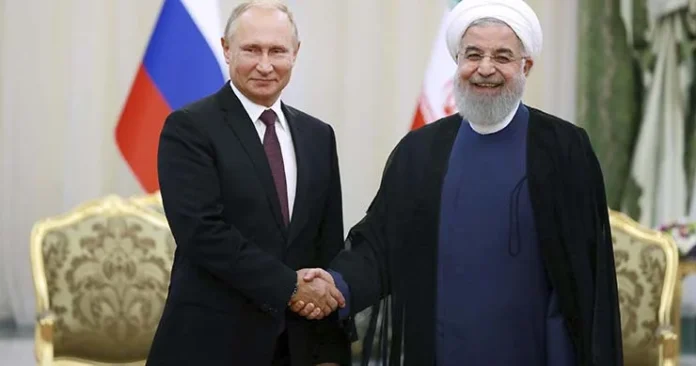Tel Aviv. Iran has requested to purchase additional Russian made Rezonans-NE radar systems to get ready for a combined US Israeli attack beginning with a strike on its early warning systems performed by F-35. Tehran asked to get the version with full signal proceeding capability that normally is not exported.
The Abu Dhabi’s request to get the stealthy fighter aircraft has also caused the urgent request from Moscow.
According to an Israeli top expert, who talked with Raksha Anirveda on condition of anonymity, said that phased array very high frequency radar has the capability to detect stealthy targets. “The question is whether the Russians will give the Iranian the full systems with top signal processing. I personally think that the Iranians will get the top version and not some export version of the systems.”
Alexander Stuchilin, the deputy CEO of the Russia-based Rezonans Research Center, told TASS news agency that this Russian made system successfully spotted and tracked US F-35 fighters near the country’s borders during an aggravation of tensions at the beginning of 2020 following the death of Iranian General Qasem Soleimani.
“At the beginning of 2020 this radar identified US F-35 planes and tracked them,” he said on the sidelines of the international military-technical forum Army-2020.
Stuchilin said that he was referring to the “well-known events of the beginning of this year.”
“The radar’s personnel were transmitting information, including the routes of F-35 flights, in clear, thus confirming that it was reliably tracking the planes. For this reason, the opponent did not commit any irreparable actions that might have caused a big war,” Stuchilin said.
He remarked that the Rezonans-NE radar had been on round-the-clock combat duty in Iran for several years.
The situation in the West Asia aggravated sharply after the January 3 US overnight attack near Baghdad airport, which killed the commander of Quds Force of the Islamic Revolutionary Guards Corps, General Qasem Soleimani. Tehran retaliated on January 8 with an overnight missile strike against two targets in Iraq that were being used by the US military: the Ain al-Assad base and Erbil airport.
Al-Sharq al-Awsat daily reported on September 1 that Iran has long sought to get its hands on advanced radar systems made in Russia so that it can deal with the F-35s.
Iranian Defense Minister Amir Hatami commenting upon his recent visit to Moscow said that talks with the officials would focus mainly on cooperation in the areas of advanced military technology.
That statement contradicts doubts about the ability of the Iranian Revolutionary Guards Corps (IRGC) to control the radar system.
This was reflected, according to the newspaper, in the incident of the downing of the Ukrainian plane in parallel with the ballistic attack on US bases in Iraq.
In January a Ukraine International Airlines Flight 752 was shot down by an Iranian missile system. After some days of total silence Tehran admitted that its forces fired an anti-aircraft missile at the Boeing 737-800 shortly after it took off from Imam Khomeini International Airport.
At the first post-incident press conference, Amir Ali Hajizadeh, commander of the IRGC Air Force and Space, said his country’s air defense systems were set to “the highest level of alertness” and were alerted to a possible cruise missile attack before the plane crash.
He added that the operator then identified what his air defense system had discovered as a cruise missile coming in from a distance of 19 km away.
However, Tehran military prosecutor Hulam Abbas said that the downing of a Ukrainian passenger plane in Iran was a human error.
According to the Russian company that makes it, the Rezonans-NE is a very high frequency [VHF] counter-stealth early warning phased-array radar designed to effectively detect a wide range of current and future air targets, including low-observable cruise and ballistic missiles, hypersonic aerial vehicles, as well as stealthy ones, in severe electronic countermeasures (ECM) and clutter environment. It is in service with the Russian Air Force, Iran (since 2009) and Algeria (since 2017).
The radar can be operated either on a circular scan mode or on a specified sector to get more precise data on an approaching target.
The Rezonans-NE consists of up to four radar modules, each of which provides control in the azimuth sector of 90 degrees and can operate independently.
The Russians claim that this radar is capable of detecting and providing target designation for air targets at a range of – up to 1200 km, in height up to 100 km.
It is important that in the coverage area of the radar complex, all aircraft created using the technology to reduce radar visibility are visible. All this is due to the fact that the Rezonans-N radar implements the principle of resonant radar to detect a wide class of air targets. The method has been worked out and tested on various mathematical models both in the field and at the test sites, where it is fully justified.
In the export version, Rezonans-NE is supplied to other countries of the world. So, the Egyptian Resonance-NE radar tracks the movement of all objects in the airspace not only over Egypt, but also Israel and Syria.
The Iranian activity points to an anticipation to a potential attack on targets on its soil. This according to Israeli sources also explains the increase of the number of air lift flights to Syria, which as per Israel carry military hardware, mainly systems for making the 14,000 rockets of the Hezbollah, Iran’s proxy in Lebanon, to say more accurately.
According to sources in Syria and Britain, in recent days Israel has stepped up its attacks on Iranian related targets in Syria, and member of the Iranian revolutionary guards were killed in these attacks.
-The writer is an Israel-based freelance journalist
-The writer is an Israel-based freelance journalist. The views expressed are of the writer and do not necessarily reflect the views of Raksha Anirveda






